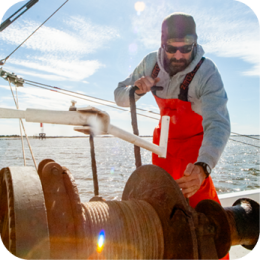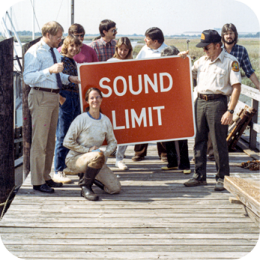Program Rules and Regulations
- A. SAFETY
Anglers must consider several factors in the pursuit of a Georgia Saltwater Gamefish Record. Primary among these is safety for the angler, crew, and/or vessel. Fishermen should carefully weigh safety demands against the inherent risks associated with certain gamefish, such as sharks, billfish, and other large species. It is ultimately the decision of the angler (and vessel captain, if applicable) to decide whether the catch can be safely accomplished under the existing circumstances and with the knowledge and equipment available.
- B. LINE
1. Monofilament, multifilament, and lead core multifilament lines may be used.
2. Wire lines are prohibited.
- C. DOUBLE LINE AND LINE BACKING
The use of a double line is not required. If one is used, it must meet the following specifications:
1. A double line must consist of the actual line used to catch the fish.
2. The double line shall be limited to 30 feet (9.14m). Double lines are measured from the start of the knot, braid, roll, or splice making the double, to the most distant end of the knot, splice, snap, swivel, or other device used for securing the trace, leader, lure, or hook to the double line.
3. The combined length of the double line and the leader shall not exceed 40 feet (12.19m).
4. Backing attached to the fishing line is permissible but must be of a type of line approved for use in these angling rules.
5. Backing not attached to the fishing line is permissible with no restrictions as to size or material.
- D. LEADER
The use of leader is not required. If one is used, it must meet the following specifications:
1. The leader shall be limited to 30 feet (9.14m). There are no minimum lengths. The length of the leader is the overall length including any lure, hook arrangement or other device.
2. The leader may not be lengthened beyond the stated limitations to compensate for a double line shorter than the maximum length allowed.
3. The leader must be connected to the line with a knot, splice, snap, swivel, or other device.
4. There are no regulations regarding the material or strength of the leader.
- E. RODS
1. Rods must comply with sporting ethics and customs. Considerable latitude is allowed in the choice of a rod, but rods giving the angler an unfair advantage will be disqualified. This rule is intended to eliminate the use of unconventional rods.
2. Cane or bamboo poles are permitted when used in accordance with normal and ethical angling practices outlined and implied in program regulations. Line, rod, terminal gear, and other equipment used must comply with these rules. Fish snagged or snatched with no opportunity to fight will not be eligible for record status. Applications for catches with cane poles must be accompanied by a full description of the equipment and capture.
- F. REEL
1. Reels must comply with sporting ethics and customs.
2. Power driven reels of any kind are prohibited. This includes motor, hydraulic, or electrically driven reels, and any device which gives the angler an unfair advantage.
3. Ratchet handle reels are prohibited.
4. Reels designed to be cranked with both hands at the same time are prohibited.
5. Specialized reels designed for use by disabled or handicapped fishermen may be allowed. Anglers using these reels, however, must submit with the record application additional background explaining the necessity of the reel, as well as a detailed description of the unit and its operation.
- G. HOOKS FOR FISHING WITH NATURAL BAIT
1. For fishing with live or dead natural baits, a maximum of two hooks (either single, double, or treble, or a combination of any two) may be used. The hooks must be firmly imbedded in or securely attached to the bait. The eyes of the hooks must be no more than 18 inches (45cm) apart. The only exception is that the point of one hook may be passed through the eye of the other hook or joined by a swivel.
2. The use of a dangling or swinging hook is prohibited.
3. A two-hook rig for bottom fishing is acceptable if it consists of two single hooks on separate leaders or drops. Both hooks must be imbedded in the respective baits and separated sufficiently to that a fish caught on one hook cannot be foul-hooked by the other.
- H. HOOKS AND LURES
1. When using an artificial lure with a skirt of trailing material, no more than two single hooks may be attached to the line, leader, or trace. The hooks need not be attached separately. The eyes of the hooks must be no less than an overall hook's length (the overall length of the largest hook used) apart and no further than 12 inches (30cm) apart. The only exception is that the point of one hook may be passed through the eye of the other hook or joined by a swivel. The trailing hook may not extend more than a hook's length beyond the skirt of the lure.
2. Gang hooks are permitted when attached to plugs and other artificial lures that are specifically designed for this use. Gang hooks shall be limited to a maximum of three hooks (either single, double, or treble, or a combination of any three). These hooks must be permanently and directly attached to the lure and must be free swinging.
- I. OTHER EQUIPMENT
1. Fighting chairs may not have any mechanically propelled devices which aid the angler in fighting a fish.
2. Gimbals must be free swinging, which includes gimbals that swing in a vertical plane only. Any gimbal that allows the angler to reduce strain or to rest while fighting the fish is prohibited.
3. Floats are prohibited except for any small flotation device attached to the line or leader for the sole purpose of regulating depth of the bait. The flotation device must not in any hamper the fighting ability of the fish.
4. Entangling devices, either with or without a hook, are prohibited and may not be used for any purpose, including baiting, hooking, fighting, or landing the fish.
5. Outriggers, downriggers, and kites are permitted to be used provided that the actual fishing line is attached to the snap or other release device, either directly or with some other material. The leader or double line may not be connected to the release mechanism either directly or with the use of a connecting device.
6. A safety line may be attached to the rod provided that it does not in any way assist the angler in fighting the fish.
7. Standard, single-hooked fixed and flying gaffs, landing nets, and tail ropes may be used to retrieve a fish when the leader has reached the rod tip. If fishing from a pier or similar structure, gaffs, landing nets, and tail ropes may be used to retrieve a fish when the top of the leader has cleared the surface of the water. Gaffs, nets, or tail ropes may not be used in any to snag, entangle, or otherwise hinder a fighting fish. Harpoon and lance attachments are prohibited.
8. Specialized equipment designed to assist disabled or handicapped fishermen may be permitted. Anglers using this equipment must submit with the record application background explaining the necessity of the equipment, as well as a detailed description of the gear and its operation
- J. ANGLING REGULATIONS
1. From the time that a fish strikes or takes a bait or lure, the angler must hook, fight, and bring the fish to gaff without the aid of any other person, except as provided in these regulations.
2. If a rod holder is used and fish strikes or takes the bait or lure, the angler must remove the rod from the holder as quickly as possible. The intent of this rule is that the angler shall strike and hook the fish with rod in hand.
3. In the event of a multiple strike on separate lines being fished by a single angler, only the first fish fought by the angler will be considered for a record.
4. A harness may be attached to the reel or rod, but not to the fighting chair. The harness may be replaced or adjusted by a person other than the angler.
5. Use of a rod belt or waist gimbal is permitted.
6. When angling from a boat, once the leader is brought within the grasp of the mate, or the end of the leader is wound to the rod tip, more than one person is permitted to hold the leader.
7. One or more gaffers may be used in addition to persons holding the leader. The gaff handle must be in hand when the fish is gaffed.
8. The angling rules and equipment regulations shall apply until the fish weighed.
- K. THE FOLLOWING ACTS WILL DISQUALIFY A CATCH
1. Failure to comply with equipment or angling regulations.
2. The act of persons other than the angler in touching any part of the rod, reel or line (including the double line) either bodily or with any device during the playing of the fish, or in giving any aid other than that allowed in the rules and regulations. If an obstacle to the passage of the line through the rod guides has to be removed from the line, then the obstacle (whether chum, float line, rubber band, or other material) shall be held and cut free. Under no circumstances should the line be held or touched by anyone other than the angler during this process.
3. Resting the rod in a rod holder, on the gunwale of the boat, or on any other object while playing the fish.
4. Handlining or using a handline or rope attached in any manner to the angler's line or leader for the purpose of holding or lifting the fish.
5. Shooting, harpooning, spearing, or lancing the fish being played (including sharks) during any stage of the catch.
6. Chumming with or using as bait the flesh, blood, skin, or any part of mammals other than hair or pork rind used in lures designed for trolling or casting.
7. Beaching or driving into shallow water any fish hooked from a boat to deprive the fish of its normal ability to swim.
8. Changing the rod or reel while a fish is being played.
9. Splicing, removing, or adding to the line while the fish is being played.
10. Intentionally foul-hooking a fish.
11. Catching a fish in a manner such that the double line never leaves the rod tip.
12. Attaching the angler's line or leader to part of a boat or other restraining object for the purpose of holding or lifting the fish.
- L. THE FOLLOWING SITUATIONS WILL DISQUALIFY A CATCH
1. When a rod breaks in a manner that severely impairs its angling characteristics.
2. Mutilations to the fish caused by sharks, other fish, mammals or propellers that remove or penetrate the flesh (Injuries caused by leader or line, old healed scars or regeneration deformities are not considered to be disqualifying injuries). Any mutilation on the fish must be fully explained in a separate report accompanying the record application.
3. When a fish is hooked on more than one line.
4. Illegal catches (ie., under-sized, out-of-season, etc.) at variance with state or federal laws.
5. Fish landed offshore shall not be eligible for record status if the vessel boating the catch enters any other state's or nation's port prior to returning to Georgia moorings.
- M. ELIGIBLE WATERS
Any catches entered for consideration as a Georgia Saltwater Gamefish Record must have been hooked in Georgia's saltwaters (as defined by O.C.G.A. Section 27-4-1) or in waters east of the Georgia coast. No applications will be accepted for entries caught in private waters or controlled private bodies of water.
Offshore entries should be caught south of the due-east line emanating from the Georgia/South Carolina border at 80⁰53’25.017”W / 32⁰02’07.991”N (O.C.G.A. 50-2-2), and north of the due-east line emanating from the Georgia/Florida border at 81⁰24’15.9”W / 30⁰42’45.6”N (O.C.G.A. 50-2-5).
Click here to download a map showing the northern and southern boundaries.
- N. GEORGIA SALTWATER GAMEFISH RECORD SPECIES
Please see the table below.
- O. SALTWATER GAMEFISH RECORDS REVIEW COMMITTEE
1. All record applications will be reviewed and evaluated by the Georgia Saltwater Gamefish Records Review Committee. All Committee decisions will be based on both the letter and intent of the regulations. The Committee's decisions will be final. Further, the Committee and DNR reserve the sole right to either grant or reject any application.
2. Catches made with new or specialized equipment and/or methods, protested applications, disputed records, and similar program issues shall be referred to the Saltwater Gamefish Records Review Committee. In the case of specialized equipment and methods, the Committee shall decide if either is justified or allow the angler an unfair advantage. Committee decisions on this and all other matters shall be final.
3. The Georgia Saltwater Gamefish Records Program shall be re-evaluated biennially and updated by the Saltwater Gamefish Records Review Committee.
4. In some instances, the Saltwater Gamefish Records Review Committee may recheck information supplied on a claim. Such action is not to be regarded as doubt of the formal affidavit, but rather as evidence of the extreme care with which the program will investigate and maintain its records.
- P. WEIGHTS NEEDED TO DEFEAT OR TIE EXISTING RECORDS
1. Minimum weights have been established for certain species and are noted in the rules. Entries in these categories should either meet or exceed the minimum weights established in order to be considered for record status.
2. To replace a record for a fish weighing less than 20 pounds (9.07 kg), the replacement must weigh at least 4 ounces (113.39 gm) more than the existing record.
3. To replace a record for a fish weighing 20 pounds (9.07 kg) up to 100 pounds (45.35 kg), the replacement must weigh at least 8 ounces (226.7 gm) more than the existing record.
4. To replace a record for a fish weighing 100 pounds (45.35 kg) or more, the replacement must weigh at least one half of 1 percent (.005%) more than the existing record weight. Example: At 200 pounds (90.71 kg) the additional weight required would be 1 pound (.45 kg).
5. Any catch which matches the weight of an existing record or exceeds the weight by less than the amount required to defeat the record will be considered a tie. In case of a tie claim involving more than two catches, weight must be compared with the original record (first fish to be caught). Nothing weighing less than the original record will be considered.
6. Estimated weights will not be accepted (See Weighing Requirements).
- Q. TIME LIMIT ON CLAIMS
1. Claims for record fish should be received within 30 days of the date of catch, although older applications properly completed will be considered for record status. It should be noted, however, that older claims are typically more difficult to verify, especially where additional information is required. In instances where an application cannot be adequately investigated, it is probable that the entry will not be accepted for record consideration.
2. If an incomplete record claim is submitted, it must be accompanied by an explanation of any certain portions which are incomplete. An incomplete claim will be considered for a record if the following conditions are met:
(a) The incomplete claim with explanations of why portions are incomplete must be received by DNR.
(b)Missing data must be due to circumstances beyond the control of the angler making the record claim.
(c) All missing data must be supplied within a period of time considered to be reasonable in view of the particular circumstances.3. Final decisions on incomplete claims will be made by the Saltwater Gamefish Records Committee.
- R. WEIGHING REQUIREMENTS FOR RECORD FISH
1. The weight of the sling, platform, or rope (if one is used to secure the fish on the scales) must be determined and deducted from the total weight.
2. The signature and address of the weighmaster (the owner or regular operator of the scale) is required on all entries. If available, witnesses to the weight and their addresses should also be included on the application. Disinterested witnesses to the weight should be used whenever possible. all record fish must be weighed on scales that have been checked and certified for accuracy by government agencies or other qualified and accredited organizations. All scales must be regularly checked for accuracy and certified in accordance with applicable government regulations at least once every twelve months.
3. If at the time of weighing the fish, the scale has not been properly certified within twelve months, it should be checked and certified for accuracy as quickly as possible and a report of the findings included with the record application.
4. DNR reserves the right to have any scale recertified for accuracy if there are any indications that the scale might not have weighed correctly.
5. No estimated weights will be accepted. Fish weighed at sea or in other bodies of water will not be accepted.
- S. SPECIES IDENTIFICATION
1. It is the angler's responsibility to provide the data and photographs necessary for proper species identification by the Saltwater Gamefish Records Review Committee. The quantity and quality of information submitted must be determined by the angler.
2. If it is possible that there may be a question regarding species identification, several clear photographs showing the full length of the fish and its distinctive anatomical features should accompany the application.
3. Further support in species identification (especially groupers, mackerels, sharks, and tunas) may be provided through verification by a qualified ichthyologist or biologist, whose examination should be attached to the application. If a catch cannot be examined immediately, the fish should be frozen or otherwise retained until identified.
4. The identification of certain species of sharks and tunas are typically difficult. Sharks should be photographed lying down to show the relative positions and characteristics of all fins and gill openings. Representative teeth from the upper and lower jaws are also useful. For younger and smaller tunas, excluding little tunny, removal and preservation of internal organs for later examination by a fishery biologist is recommended.
- T. PREPARATION OF RECORD CLAIMS
1. To apply for a state record, the angler must submit a Georgia Saltwater Gamefish record application form and an acceptable photograph of the angler and the fish. Any additional photographs taken or needed for species identification should also be submitted with the application.
2. The official Georgia Saltwater Gamefish record application form must be used for record claims. This form may be reproduced as long as all items are included. The angler should fill in the application personally. It is also recommended that the angler personally mail the application and photographs. Extreme care should be exercised in measuring the fish as the measurements are often important for weight verification and scientific studies. See the measurement diagram on the record application to be sure you have measured correctly.
3. The angler is responsible for seeing that the necessary signature and correct addresses of the boat captain, weighmaster, and witnesses are on the application. 4. On record claims, witnesses to the catch are highly desirable if possible.
5. Any deliberate falsification of an application will disqualify the applicant for any future state record and any existing records will be nullified.
- U. PHOTOGRAPHS
1. A photograph of the angler with the fish is required. If possible, the rod and reel used to make the catch and the scale used to weight the fish should be included.
2. Digital photographs are preferred (high resolution) but are not a prerequisite for proper submission of a record application.
3. All photographs submitted with record applications become the property of DNR and may be used in program news releases, publications, and exhibits.
- V. OUTSTANDING CATCH
Catches that do not qualify for gamefish record status are eligible for recognition as an Outstanding Catch. Examples of applications that may be considered by the Saltwater Gamefish Records Review Committee include landings of non-record program species, near-record entries, catches made under exceptional conditions (angler age, etc.) and circumstances, fights demonstrating outstanding angling abilities and sporting ethics, and more. Upon approval, catches such as these will receive appropriate certification and will be filed for later consideration for inclusion in the records category. If an Outstanding Catch is approved for entry onto the list of species eligible for saltwater record status, then it and all other outstanding catches of that particular fish will be considered for saltwater gamefish record status.
- W. FOR MORE INFORMATION OR QUESTIONS
Contact the Georgia Saltwater Gamefish Records Program, Coastal Resources Division, Georgia Department of Natural Resources, (912) 264-7218 or visit CoastalGaDNR.org and visit the Recreational Fishing page or use the Contact Us button.
![]() Download Program Rules and Regulations
Download Program Rules and Regulations







